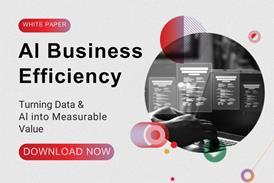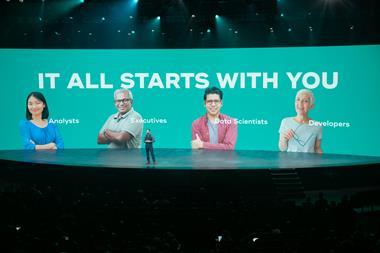- If AI and ML are your future, make sure the data foundations are in place. Requirements and applications change but the need for a solid data base does not.
- Your data vision should be holistic, released from the complexity and inefficiency of hundreds and even thousands of siloes. Use your data scientists to guide your business, not clean up systemic mess as data janitors.
- Today, focus is too often on modelling and subscale, neglecting data preparation and analytics operationalisation. These are critical to achieving the value promise from the digital transformation.
- Incremental gains from analytics are rewarding, and can clear out technical debt and leverage existing assets, but the big win will come with business model reinvention.

The case for a digital transformation strategy that embraces digital analytics is a familiar one, but there are challenges in implementation, and in recognising the work — and, more importantly, the right type of work — necessary to reap the benefits.
Speaking to Vodafonewatch, technical and consulting leaders across data orchestrator Teradata assert that many digital transformation projects are being restrained by limited ambition, complex technical architectures, and insufficient focus on the commercial value of data. They stress that not enough work is going into fundamentals of data quality and the operationalisation of insights.


Analytics deployments are said to be struggling to break out of functional and technical confines to deliver benefit across businesses. As a consequence, Teradata estimates that the majority of data migration initiatives globally will run over time and over budget in the coming 18 months.
For telcos, as well as peers in other sectors, the challenge is exacerbated because transformation initiatives are rarely greenfield, with considerable legacy investment to address and complex systems to take into account.
A key aspect that Teradata is seeking to address is ensuring that effort already expended on digital change is applied in the right way, in the right areas, to best result. This is then accompanied by significant opportunity for radical change, and a growing need to act urgently.
According to Martin Willcox, EMEA Regional Vice-President for Technology at Teradata, this opportunity may see some industries “completely reinvent” business models, noting “that’s why the likes of Amazon and Google and Apple are all still playing this game”.
This will, however, depend on operators applying a level of foresight, according to Michael Ingemann, Teradata’s Director of CFO Services.
“The last barrier is acceptance that it’s not all about ‘the output’. It’s not about an ‘application’ or a ‘BI tool’. It’s about the foundation of data. It’s like building a house, and 50% of what you spend is in the foundations. You might not see it, but, if you don’t have that, you don’t have a house.”
Ingemann.
Analytics 123: looking beyond “the sexy bit”
Teradata promotes the concept of Analytics123: breaking down the process of building data-driven solutions into three discrete stages covering data management through to deployment of models. The need for this clarification emerged as it became clear that businesses often fail to recognise all of the key elements required to develop accurate and effective models and consequently misallocate resources, leading to inefficient builds and higher costs. This dents confidence in, and enthusiasm for, artificial intelligence (AI) and machine learning (ML) solutions. This imbalance, according to Willcox, is based on an over-emphasis on ‘training’ models: “everybody wants to focus on building data models because that’s the exciting ‘sexy’ bit”.
“Spending a fortune on building models is not productive on its own. It’s a great way of making analytics a ‘cost centre’ in your organisation, but it’s not a great way of changing your business.”
Willcox.
The Analytics 123 approach breaks down delivery of effective AI/ML-driven data analytics into three stages:
- Preparation — accessing and cleansing data while drawing out key attributes.
- Training — selecting ML algorithms, and testing, training and optimising the model.
- Deployment — using models operationally to predict outcomes as part of ongoing business processes, and feeding back in to data for re-use.
The full white paper, Analytics 123: Enabling Enterprise AI at Scale can be accessed online, co-authored by Willcox and Dr. Chris Hillman (Principal Data Scientist at Teradata).
Data to fuel a ’90s telco revival
The transformation that telcos can achieve with adoption of digital analytics opens up radical opportunities linked to business models that may still be hard to envisage, according to the Teradata team.
Willcox compares the current state of data modelling in telco to the original networking revolution in the 1990s that saw business embrace IT, with huge levels of associated spending but little immediate benefit. Levels of productivity across developed economies remained flat for a sustained period despite organisations “shovelling money at IT”.
He considers that it was only when business process innovators reengineered ways of working based on the new technology that meaningful change happened.
“Pioneers had to show the rest of us that you weren’t given this technology to automate the existing business processes. You were given this technology to completely reinvent them, and make them more customer-centric, and make them leaner, and to knock down the boundaries inside your organisation.”
Willcox.
This revelation prompted a late-90s economic productivity boom and Willcox foresees that operators’ recognising today’s new shift in the way of doing business can again derive great advantage.
“When configurations change, there will initially be marginal gains, but for the organisations that are getting it right today, like STC, even those marginal gains are already pretty impressive. But we won’t really see the true extent of the opportunity until an operator just totally changes its business model on the basis of the potential of data analytics.”
Willcox.
Incumbent Saudi Telecom (STC) is described as “brilliant” by Willcox, who highlights the effectiveness of its customer experience, which is built on deep analysis of subscriber data. While acknowledging that STC does not operate under the confines of Europe’s GDPR, he notes that it employs a double opt-in and that “people don’t [opt-out] because the loyalty scheme is so fantastic (why would you?)”. STC is said to have an exceptional “industrialised approach to analytics”, including its grasp of project scope and getting data management “right”.
Establishing the data base
Hillman considers that, when tackling data analytics, the focus is on the wrong part of the equation. He urges the telecoms sector to “stop framing this as an ‘algorithm problem’; it’s a ‘data problem’”. Cutting through this mythologising, he stresses that “algorithms are maths; they can be commoditised”. The value, he determines, is in the data that goes in to training them.
The importance of data as the base of the analytics model can be seen in the way that digital-native giants voraciously seek out new sources to enrich their modelling.
“Why is Google interested in banking now? Do you think it wants the regulatory hassle of banking licences? It’s the transaction data that makes it worthwhile. It’s what you’re buying. That’s why Google is interested, why Apple is interested.”
Hillman.
The machine learning avalanche
The ability to apply the output of data models quickly and efficiently across a telco is now becoming essential. “If you look at the trajectory and how machine learning is changing, there’s an avalanche of models coming in the near future”, explains Willcox.

This will draw on wider use of data analytics in business processes, as operators look to make changes such as adopting hyper-segmentation as a logical extension of assimilating web giants’ best practices (see Teradata: telco leaders must step up to seize data opportunity).
Willcox gives the example of retail applications, where propensity models may in the future be undertaken for each individual consumer or engagement, resulting in millions of models where previously there were a couple of dozen. Telcos that have seen data teams produce just a handful of models in any given year will be “staring down the barrel of a future featuring tens or even hundreds of millions of models”, he warns.
“What is not quite good enough today is in no way going to meet the demands of tomorrow. Operators need to start thinking about this holistically as a three-stage process, instead of putting all their time and energy just into modelling.”
Hillman.
VODAFONE ACCOUNT TEAM
Matt Stubbs Rob Anderson Natalia Macpherson Dino Kühl | Teradata provides a multi-cloud, strategic data platform for enterprise analytics. This creates a unified and connected ecosystem to deepen insight and unlock data as a digital organisation’s greatest asset.
Originally created as a pioneering research collaboration between California Institute of Technology and Citibank’s Advanced Research Group, Teradata is synonymous with enterprise-class data. This heritage is characterised in performance at scale, as well as ultra-resilience, world-class NPS, and innovation (including facilitating AI, deep learning and IoT). Teradata has deep roots in telecoms, as well as academia and financial services, including a passage within AT&T.
In recent years, Teradata has transformed itself into a full-fledged software player, most notably with its Vantage software-as-a-service platform that bridges multi-cloud, internal and hybrid technology environments. | Many of the world’s largest and most successful organisations rely on Teradata to coordinate and exploit their strategic data, including the latest generation of digital leaders and transformers that explicitly exploit data for competitive advantage. Teradata is an award-winning supplier to Vodafone, working at Group-level and with most if not all Local Markets to help orchestrate and leverage its strategic data. Use cases encompass cloud, big data, data lake, financial analyses and reporting, operations, and customer insight and experience.
Beyond pure-play software, Teradata experts help their customers operationalise strategic data, be that to speed up digital transformation, enable the application of AI at scale, or make data more accessible to end-users. Teradata forms channel partnerships on vertical markets, including telco, and has its own partner ecosystem that includes leading system integrators Accenture, Capgemini, IBM, Infosys, TCS, and Wipro. |
REVENUE: $2bn (FY20) | ||
HEADCOUNT: c. 9,000 | ||
HEADQUARTERS: San Diego, USA | ||
GEOGRAPHIC: c. 60 offices in 40 countries | ||
FOUNDED: 1979 | ||
WEBSITE: teradata.com/industries/telco |
Now is the time for telco CFOs to go holistic on the business
To reach a phase where data analytics is providing benefits throughout the business, the quality of input will be essential.
Michael Ingemann strongly believes that the finance department should be the driver of organisational change, as it already has the skills to deliver the necessary precision — but only if it can pair this with a more ambitious vision to transform the wider business. “It’s essential to remove the silos and develop a data platform, a solid data foundation based on all kinds of data”, he elucidates, “but doing that alone doesn’t help you much. You need to find out what to do with it”.
The Teradata consultant highlights the opportunity to develop highly granular multi-dimensional profitability solutions that go beyond the traditional boundaries of the finance or technical team, citing a customer that has created an engine to handle ten billion rows of data with more than 100 dimensions or columns.
“When you can combine revenue and costs with cost drivers and value drivers in a profitability model, it can become an input for many other things. To do that, you need a lot more than just SAP data. You need call centre data. You need customer data, call detail record [CDR] data. There are organisations that are buying into the concept of developing from a finance foundation with financial and non-financial data in a way that is truly visionary.”
Ingemann.
He considers that in finance departments across the telecoms sector there is an understanding of the value of delivering a solid data foundation, and the elimination of silos, but also trepidation at the size of the task involved. He considers there will be substantial benefits from taking the first steps.
“It’s never completely black or white, but if you have 1,000 silos and you could turn that down to 200 silos, then you can already benefit a lot. Data will be better, it will go faster, it will have more insight.”
Ingemann.
From artisanal to industrial data
Willcox describes the development of ML within telcos, to date, as a “handcrafted, artisanal process” ill-suited to the next phase of development that will see “millions” of models created. He stresses that data professionals are highly skilled and valuable people, while noting that “we’re going to have to work with them differently in order to industrialise”.
According to Teradata, too much of the work of data scientists is academic or theoretical in nature, and not treated commercially enough to achieve the impact it should. Willcox believes value is only crystallised when predictions become actionable. “There’s no return on investment until you’re in production”, he argues.
He further considers that modelled predictions need to be “available at the moment of truth”, which can mean operating in “near real-time”. They also need to be put in front of a decision maker — whether human or software — positioned to act.
Making the most of what telcos already have

Teradata outlines scenarios where operators with the right data foundations, and a willingness to think about the benefits of data holistically, will also be in a position to make better use of the legacy resources they already have invested in.
Operators, which have been selecting best-in-class tools and technologies for decades, “could achieve 90% of what they really need [at this point] as an organisation —both within IT and outside IT— with tools they already have”, suggested Matt Stubbs, Teradata’s Sales Director.

Having strong data foundations means that existing tools can be used more efficiently and effectively. “It doesn’t have to be that you go out and buy another solution or tool, just because a new business need has popped up”, with Stubbs explaining that an accessible data foundation also helps a business standardise its toolset organisation-wide.
Teradata Lead Solutions Architect Rob Anderson reinforces the point, saying that more effective use of existing investments is a potent upside of a base of solid data, fostering simplification through a platform approach that enables “the use of the right tool for the right purpose”.
“It all comes back to the data. The analytics tools to build the models are always going to evolve. There’s always going to be a new technique, but the base fundamental is that you’re going to need data in order to use them, and I think we provide the best possible way to serve and provide the data to build and serve and train and release these analytics models.”
Anderson.
Promoting data scientists from ‘data janitor’
Willcox maintains that, as a result of a lack of strategic focus on building the right foundations, data science projects take too long to initiate, with the vast majority of time and effort inefficiently spent cleansing data rather than putting it to effective use. With a common complaint among data scientists being that they are effectively “data janitors”, he wryly describes the current counter-productive approach as “the gift that keeps on giving”, with multiple data silos continuing to be built, and little thought given to longer term applications.
He suggests that many major businesses are building up “a mountain of technical debt” as inefficient processes perpetuate, and this problem will only worsen as data models proliferate. “We need to fix the problem for operators where 80% of their data scientists spend 80% of their time wrangling data, so we can give them an execution challenge to score the models at scale” elaborates Hillman.
Hillman emphasises this point: “You shouldn’t have expensive resources analysing and processing the same data 25 times to engineer essentially the same features. You need to be doing that once, and the answer is in the data management. Get the data management right; that’s the only way this scales”.
“Increasingly, model building is an automatic process. The tools are there to create the best model based on the data itself. The differentiator for an operator will be the features and the data that go into a model.”
Hillman.



































